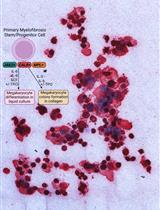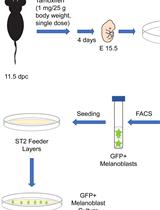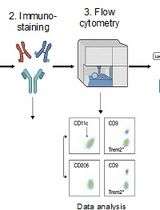- EN - English
- CN - 中文
Dissecting the Rat Mammary Gland: Isolation, Characterization, and Culture of Purified Mammary Epithelial Cells and Fibroblasts
解剖大鼠乳腺:纯化的乳腺上皮细胞和成纤维细胞的分离,鉴定和培养
(*contributed equally to this work) 发布: 2020年11月20日第10卷第22期 DOI: 10.21769/BioProtoc.3818 浏览次数: 6508
评审: Gerlinde Van de WalleJalaj GuptaIrit AdiniAnonymous reviewer(s)

相关实验方案

来自骨髓增生性肿瘤患者的造血祖细胞的血小板生成素不依赖性巨核细胞分化
Chloe A. L. Thompson-Peach [...] Daniel Thomas
2023年01月20日 2300 阅读
Abstract
With the advent of CRISPR-Cas and the ability to easily modify the genome of diverse organisms, rat models are being increasingly developed to interrogate the genetic events underlying mammary development and tumorigenesis. Protocols for the isolation and characterization of mammary epithelial cell subpopulations have been thoroughly developed for mouse and human tissues, yet there is an increasing need for rat-specific protocols. To date, there are no standard protocols for isolating rat mammary epithelial subpopulations. Analyzing changes in the rat mammary hierarchy will help us elucidate the molecular events in breast cancer, the cells of origin for breast cancer subtypes, and the impact of the tumor microenvironment. Here we describe several methods developed for 1) rat mammary epithelial cell isolation; 2) rat mammary fibroblast isolation; 3) culturing rat mammary epithelial cells; and characterization of rat mammary cells by 4) flow cytometric analysis; and 5) immunofluorescence. Cells derived from this protocol can be used for many purposes, including RNAseq, drug studies, functional assays, gene/protein expression analyses, and image analysis.
Keywords: Rat (大鼠)Background
Most mammary-related research has been performed in mouse models and human samples. However, rat models of disease are becoming increasingly popular due to their human-like pharmacokinetic profile and mammary development (Russo et al., 1990; Jiunn et al., 2008; Smalley et al., 2016). Like human adenocarcinomas, rat mammary carcinomas go through stages of histological progression (Russo et al., 1990; Singh et al., 2000) and are ovarian hormone dependent (Thompson et al., 1998; Dischinger et al., 2018), making them ideal models for human breast cancer research. Mammary development can be divided into distinct stages: embryonic, pubertal, adult, pregnancy/lactation, and involution. In order to investigate specific mammary cell populations, it is necessary to separate the mix of epithelial (parenchymal) and stromal (mesenchymal) cell populations within the mammary gland. The gland is composed of luminal secretory alveolar and ductal cells, and basally positioned myoepithelial cells organized into ducts that drain milk from lobuloalveolar structures (Stingl et al., 2006; Shackleton et al., 2006; Sleeman et al., 2006; Asselin-Labat et al., 2006). The luminal layer contains ER-negative cells, which are mostly proliferative progenitors, and terminally differentiated ER-positive cells (Shehata et al., 2012). The basal layer consists of mammary stem cells and myoepithelial cells which function to mechanically contract alveolar cells to release milk droplets into the ductal lumen (Soady et al., 2015). Luminal and basal cells are presumed to come from a bipotent progenitor, derived from a mammary stem cell (Shackleton et al., 2006; Rios et al., 2014). This differentiation state-dependent lineage is termed the mammary epithelial hierarchy and the delineation of this hierarchy has vastly improved our understanding of the origins of breast cancer (Lim et al., 2009).
To study the rat mammary epithelial hierarchy, we developed a method to isolate rat mammary epithelial cells (MEC) from the extensive stromal components within the mammary fat pad. Following MEC isolation, we used immunophenotyping, morphology, and immunofluorescence to verify the identity of the selected cells. Concurrently, we assembled a panel of antibodies directed toward well-characterized antigens to prospectively isolate mammary cell populations. The cellular composition of mouse and human mammary glands has been well-defined by multicolor flow cytometric analysis of cell surface proteins (Tornillo et al., 2015) by using highly optimized protocols (Smalley et al., 2012). Previously, a panel of rat-specific antibodies to mammary markers was used to characterize the adult rat mammary parenchyma (Dundas et al., 1991) while a different panel was used to quantify epithelial cell differentiation in adult carcinogen-treated rat mammary glands (Sharma et al., 2011). To our knowledge, no one has used flow cytometry to profile mammary development in rats using pre-conjugated, commercially available antibodies. In this protocol, we used antibodies targeted to hematopoietic (CD45+) and endothelial (CD31+) cells to exclude lineage positive populations in freshly isolated, monodispersed mammary populations (Shackleton et al., 2006). Then we used CD24 and CD29 to separate luminal (CD24hiCD29low) from basal/mammary stem cell enriched populations (CD24midCD29hi, Shackleton et al., 2006; Sleeman et al., 2006). By combining the methods above, we are able to isolate, characterize, and culture distinct rat mammary gland cell populations to study their contribution to breast cancer.
Materials and Reagents
Sterile 100 mm tissue culture plate (Corning, catalog number: 430167 )
Eppendorf tubes
15- and 50-ml conical tubes (Greiner Bio-One, catalog numbers: 188271 and 227-261 )
5- and 15-ml round bottom (BD Falcon, catalog numbers: 352063 and 352059 )
Glass Pasteur pipettes
40 μm cell strainer (Corning, catalog number: 149925 )
Fisherbrand Cover Glasses (Thermo Fisher Scientific, catalog number: 12-545F )
0.22 μm Steriflip filter (Millipore, catalog number: SCGP00525 )
CellTrics cell strainer (Sysmex, catalog number: 04-0042-2316 )
Ultra-low attachment plates, 6-well (Corning, catalog number: 3471 )
LS columns (Miltenyi, catalog number: 130-042-401 )
T25 tissue culture flask
Sterile scalpels (Feather, catalog number: EF7281 )
Nunc Lab-Tek II Chamber Slide System (Thermo Fisher Scientific, catalog number: 154534 )
8-40 days old Sprague-Dawley rats (Charles River Labs, catalog number: SAS Sprague-Dawley® Rat (SD) | 400 )
70% Ethanol
HBSS (Gibco, catalog number: 14025-092 )
EpiCult B Basal Media and Proliferation Supplement (STEMCELL Technologies, catalog number: 05610 )
Fetal Bovine Serum (FBS) (VWR, catalog number: 1300-500 )
Penicillin-Streptomycin (10,000 U/ml) (Gibco, catalog number: 15140-122 )
Recombinant human epidermal growth factor (Sigma, catalog number: E9644 )
Human fibroblast growth factor (STEMCELL Technologies, catalog number: 78003.1 )
Heparin (STEMCELL Technologies, catalog number: 07980 )
Gentle collagenase/Hyaluronidase (STEMCELL Technologies, catalog number: 07919 )
Ammonium chloride (STEMCELL Technologies, catalog number: 07800)
0.05% Trypsin-EDTA (Gibco, catalog number: 25300-054 )
Dispase (STEMCELL Technologies, catalog number: 0 7913 )
DNase I (STEMCELL Technologies, catalog number: 0 7900 )
Dead Cell Removal Kit – includes dead cell removal microbeads and binding buffer (Miltenyi, catalog number: 130-090-101 )
Sterile double distilled water
CD31-biotin (Miltenyi, catalog number: 130-105-935 )
CD45-biotin (Miltenyi, catalog number: 130-107-841 )
Anti-biotin microbeads (Miltenyi, catalog number: 120-000-927 )
DMEM/F12 media, no phenol red (Gibco, catalog number: 21041-025 )
Horse Serum (Gibco, catalog number: 16050-122 )
Hydrocortisone (Sigma, catalog number: H0888 )
Insulin (Sigma, catalog number: I6634 )
Cholera toxin (Sigma, catalog number: C8052 )
DAPI (Thermo, catalog number: 28718-90-3 )
Antibodies for flow analysis:
CD31-BB515 (BD Biosciences, catalog number: 565408 )
CD45-PE-Cy7 (BD Biosciences, catalog number: 561588 )
CD29-AF647 (BD Biosciences, catalog number: 562153 )
CD24-PE (BD Biosciences, catalog number: 562104 )
Phosphate-buffered saline (PBS), pH 7.2 (Gibco, catalog number: 10010-023 )
Bovine serum albumin (BSA) (Sigma, catalog number: A7906 )
EDTA (Fisher Chemical, catalog number: E478-500 )
DMEM/F12 nutrient media (Gibco, catalog number: 11320033 )
10 mg/ml Gentamicin (Thermo Fisher Scientific, catalog number: 15710064 )
Y-27632 (Tocris, catalog number: 1254 )
0.25% trypsin (Thermo Fisher Scientific, catalog number: 25200-056 )
Rat skin collagen (we isolate this in-house, see below for reference) or use the following commercially available collagen – Collagen 1, rat tail (Gibco, catalog number: A10483-01 )
Glacial acetic acid (Sigma-Aldrich, catalog number: 695092 )
Formaldehyde (Sigma-Aldrich, catalog number: 252549 )
SMA-488 (Cell Signaling, catalog number: 34105 )
Tween-20 (Sigma-Aldrich, catalog number: P1379 )
Triton X-100 (Sigma-Aldrich, catalog number: X100 )
Methanol (Sigma-Aldrich, catalog number: 322415 )
Normal Goat serum (Cell Signaling, catalog number: 5425 )
ProLong Gold Antifade Mountant (Thermo Fisher Scientific, catalog number: P36930 )
Trypan blue (BioRad, catalog number: 1450021 )
Complete EpiCult B Medium (see Recipes)
Selection buffer (see Recipes)
HF Solution (see Recipes)
MEC media (see Recipes)
Fibroblast media (see Recipes)
Antibody dilution buffer (see Recipes)
Blocking buffer (see Recipes)
3.7% Formaldehyde (see Recipes)
PBST wash buffer (see Recipes)
Equipment
Pipettes
Pipette aid
Sterile scissors and forceps
Centrifuge
Humidified cell culture incubator (5% CO2, 37 °C)
Vortex
Miltenyi QuadroMACs magnet (Miltenyi, catalog number: 130-090-976 )
TC20 Automated Cell counter (Bio-Rad, model: 1450102 )
Biosafety cabinet for cell culture work
CytoFLEXS (Beckman Coulter, model: C09766 )
EVOS FL Imaging System (Thermo Fischer Scientific, model: AMF4300 )
Nikon A1plus-RSi Laser Scanning confocal microscope (Nikon)
Nikon oil immersion 60x Plan Apo VC with 1.4 NA (Nikon)
Refrigerator
Software
CytExpert v2.1 (Acquisition)
FlowJo v10.6.2 (Analysis)
Nikon Elements v5.11.00
FIJI (imagej.nih.gov/ij/download)
Procedure
文章信息
版权信息
© 2020 The Authors; exclusive licensee Bio-protocol LLC.
如何引用
Tovar, E. A., Sheridan, R., Essenburg, C. J., Dischinger, P. S., Arumugam, M., Callaghan, M. E., Graveel, C. R. and Steensma, M. R. (2020). Dissecting the Rat Mammary Gland: Isolation, Characterization, and Culture of Purified Mammary Epithelial Cells and Fibroblasts. Bio-protocol 10(22): e3818. DOI: 10.21769/BioProtoc.3818.
分类
癌症生物学 > 瘤形成 > 离体组织培养模型
细胞生物学 > 细胞分离和培养 > 细胞分离 > 流式细胞术
您对这篇实验方法有问题吗?
在此处发布您的问题,我们将邀请本文作者来回答。同时,我们会将您的问题发布到Bio-protocol Exchange,以便寻求社区成员的帮助。
Share
Bluesky
X
Copy link













